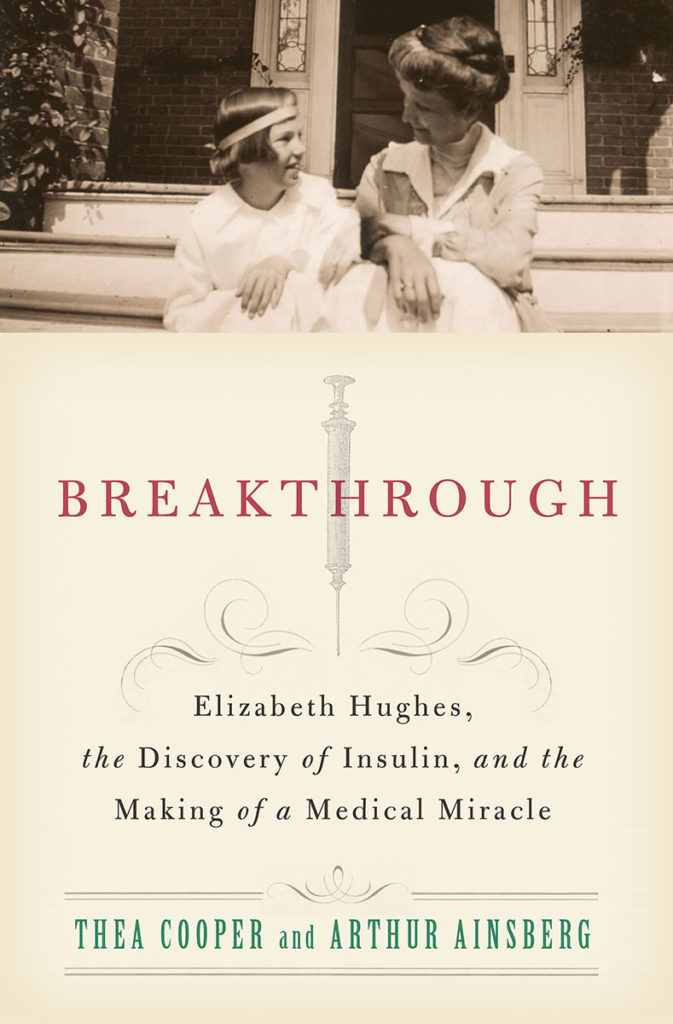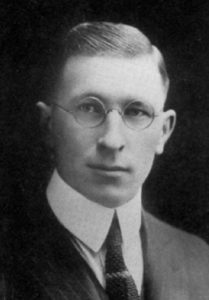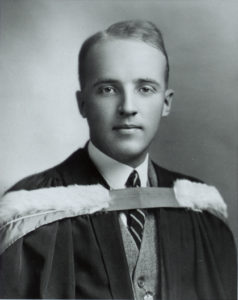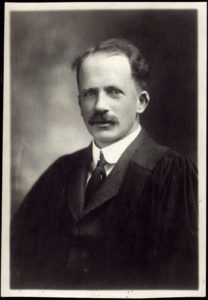Breakthrough
 Title: Breakthrough: Elizabeth Hughes, the Discovery of Insulin, and the Making of a Medical Miracle
Title: Breakthrough: Elizabeth Hughes, the Discovery of Insulin, and the Making of a Medical MiraclePublished by: St. Martin's Press
Buy the Book: Amazon, Barnes & Noble, IndieBound
Overview
One of the most important medical breakthroughs of our time is the discovery of insulin, which has and continues to save millions of lives world-wide. Yet no book has offered a vivid, immediate portrayal of the complex characters of this extremely intricate story – until now.
Ninety years after Dr. Frederick Banting had an idea that would unlock the mystery of the dreaded diabetes disorder in a University of Toronto lab, comes a new book that recreates the discovery with the suspense and drama of a thriller: BREAKTHROUGH: Elizabeth Hughes, the Discovery of Insulin, and the Making of a Medical Miracle by Thea Cooper and Arthur Ainsberg. Through the prism of the fragile life of a young girl, this remarkable breakthrough comes to life.
In 1918 Elizabeth Hughes stands in the kitchen of her family’s elegant townhouse in New York City, fiercely gulping water from a glass. She is the daughter of Charles Evans Hughes, one of the city’s most highly respected and recognizable citizens. Although Elizabeth doesn’t yet know it, she has what was then an unerringly fatal disease – juvenile diabetes mellitus. In a few short months, what had been a happy, active childhood will be eclipsed by the mounting symptoms of ravenous hunger and insatiable thirst.
In Toronto, a surgeon named Frederick Banting and a student named Charles Best succeed in purifying insulin from animal pancreases. Within months this miracle is nearly derailed by scientific jealousy, intense business competition, and at least one fistfight. In a race against time and a ravaging disease, Elizabeth becomes one of the first diabetics to receive insulin injections. As less fortunate children die, the discoverers work with a little-known pharmaceutical company named Eli Lilly and Company to make insulin available.
BREAKTHROUGH is everything popular history should be – an enthralling story meticulously researched and presented to appeal to readers of all ages.
A portion of the proceeds from the sale of this book will be donated to the Juvenile Diabetes Research Foundation and the Life for a Child Program of the International Diabetes Federation.
Praise
"With insulin, dying children laughed and played again, as parents wept and doctors spoke of biblical resurrections."
—The New York Times
"... the authors' ... are adept at telling their complicated, multifaceted story with energy and vividness. Their account of diabetics' treatment before the production of insulin is harrowing."
—The Washington Times
"Fourteen-year-old Elizabeth Hughes was among the first wave of patients to benefit from the marriage of dogged research and commercial enterprise on the part of Lilly & Co. to manufacture the drug. Author and playwright Cooper and finance-veteran-turned-author Ainsberg bolster the account with impressive sourcing. They also pay particular attention to the complexities of the human drama--the indomitable Elizabeth; her visionary parents; the quarrelsome, 'crazy,' and eventual Nobel Prize–winning researchers; and the bold commercial pioneers. And it's those details that make this extraordinary chapter of medical history so memorable."
—Publishers Weekly
"A work that sometimes reads like a novel, with the characters brought to life through their... thoughts, remarks and physical gestures…A readable tale of medical achievement."
—Kirkus Review
"... Thea Cooper and Arthur Ainsberg follow the discovery of insulin and the revolution it sparked in diabetes treatment ..."
—Laura Landro, "Wellness Reading List: Five Top Picks of 2010," The Wall Street Journal
"[Breakthrough] successfully weaves together the personal struggles of the patients, doctors and scientists living and dying on the edge of one of medicine's greatest discoveries."
—Peter Lipson, physician and medical blogger, at Forbes.com
"Breakthrough is a meticulously researched story..."
—San Franscisco Book Review
"It's easy to read in history books that the discovery of insulin was a medical miracle. But what emerges from the show, inspired by a new, similarly titled book by Thea Cooper and Arthur Ainsberg, are the emotions tied up in it."
—The L Magazine
"'Breakthrough: Elizabeth Hughes, the Discovery of Insulin, and the Making of a Medical Miracle,' by Thea Cooper and Arthur Ainsberg, captures the complex human drama of the teenage girl who was saved by insulin... [Elizabeth's] story – a remarkable brew of courage, triumph, secrecy, and shame – resonates to this day, and new details of her life emerge in a book that will be published later this year."
—James S. Hirsch, award-winning journalist and author
“Breakthrough is terrific! The authors’ blending of the events of the time with the trials of discovery and with the pain of diabetes for patients, families and caregivers, creates a powerful story of one of medicine’s greatest discoveries. Thea Cooper and Arthur Ainsberg are to be congratulated for a really fine book.”
—Dr. Kenneth Quickel, President and CEO, Joslin Diabetes Center
"Through their portrayal of Elizabeth Hughes' dramatic life story, Thea Cooper and Arthur Ainsberg give us a full appreciation of how far diabetes management has come, and how fortunate we are to have the tools of today to help us live full lives."
—Charlie Kimball, Professional Race Car Driver with Type 1 diabetes
"Breakthrough is the fascinating tale of Nobel prize-winning research, of a young girl who should have died as a child but instead lived to see seven grandchildren, and of a drug that turned a death sentence into something more akin to a chronic nuisance. This book is an important read for anyone with diabetes. It is an enjoyable read for those who love mystery and human drama."
—Dr. Kenneth T. Jackson, Barzun Professor of History, Columbia University
Inspiration
Arthur Ainsberg was inspired to write BREAKTHROUGH after reading an article in the Sunday New York Times in 2003. The article gave a broad outline of the discovery of insulin, focusing on Elizabeth Hughes and her struggle to survive against extraordinary odds. As she was succumbing to her fate from an incurable disease, a miracle occurred—the discovery of insulin—and Elizabeth lived.
Elizabeth’s story mirrors Arthur’s own life experience. In 1975, at the age of 28, he was stricken with a disease that had been, for thousands of years, incurable: Hodgkin’s Disease. At the time of his diagnosis, doctors at Stanford University Medical Center had developed a mode of treatment, involving both chemotherapy and radiotherapy, that was curing Hodgkin’s Disease patients. Arthur was lucky enough to be one of these patients who was cured. As in Elizabeth’s case with diabetes, there were no support groups for Hodgkin’s survivors in 1975. The parallels between Elizabeth’s and Arthur’s paths from sickness to health are remarkable.
Arthur shared the New York Times article with Thea Cooper, a friend and writer. It was a conversation that would change both of their lives. As they delved into the story of how insulin was discovered, they were certain that this was a story they simply had to tell. Together, they embarked on an exploratory research effort that would ultimately take them to medical centers, universities, libraries, archives, and other sites of significance located in twenty-five cities and towns in eight states and four countries over the course of five years.
Initially, their research focused on Elizabeth Hughes, but they soon discovered that she was the nucleus of a constellation of characters, each of whom was as fascinating and enigmatic as Elizabeth herself. The discovery of these new characters led inexorably to more research and more findings. At a certain point their biggest challenge became choosing which of the many engaging characters and stories to focus on.
The two geographic hubs of their research corresponded to the two primary locations of the development of insulin: Toronto, Canada and Indianapolis, Indiana. Arthur and Thea went to great lengths to physically place themselves in the locales in which the primary characters lived and traveled nearly ninety years ago.
The proliferation of diabetes in today’s world is a great concern. There are 23.6 million people in the United States, or 7.8% of the population, who have diabetes, and 5 to 10 % have Type 1 diabetes, meaning that they are completely dependent on insulin to stay alive. In fact, nearly everyone who picks up BREAKTHROUGH will have some personal connection to the disease.
Research
Our story began with a casual glance at an article in The New York Times Magazine in March 2003. It led to a consuming research project that would take us to medial centers, universities, libraries, archives, and other sites of significance located in twenty-five cities, eight states and four countries over the course of five years.
Initially, our research focused on Elizabeth Hughes, but we soon discovered that she was the nucleus of a constellation of characters, each of whom was as fascinating and enigmatic as Elizabeth herself. The discovery of these new characters led inexorably to more research and more discoveries. At a certain point, our biggest challenge became choosing which of the many engaging characters and stories to focus on.
Eventually we decided to focus on four primary characters: Elizabeth Hughes Gossett, Frederick Grant Banting, Frederick Madison Allen and George Henry Alexander Clowes. It was particularly difficult to relegate the captivating personality of Charles Evens Hughes to a second tier of importance. The remarkable J.K. Lilly, Sr., along with his sons Eli Lilly, Jr. and J.K. Lilly, Jr. also introduced tangential story lines that were hard to resist.
The two geographic hubs of our research corresponded to the two primary locations of the development of insulin: Toronto, Canada and Indianapolis, Indiana. We went to great lengths to physically place ourselves in the rooms and on the roads in which the primary characters lived and traveled nearly ninety years ago.
Indispensable to our research—among many other University archives and historical sites—was the archive at the Thomas Fisher Rare Book Library at the University of Toronto and the Eli Lilly and Company corporate archive in Indianapolis. These archives gave us access to primary documents and objects related to our story.
At Thomas Fisher we found a wealth of material including Elizabeth’s daily dietary and insulin record, written in her own hand, Bantings diaries and even the jarred pancreas of Leonard Thompson. The Eli Lilly archive yielded internal correspondence between Clowes and the Lilly family, as well as other important documents and paraphernalia.
Several books were critical to our research: The Discovery of Insulin and Banting: A Biography, by Michael Bliss, professor of the history of medicine at the University of Toronto; Charles Evans Hughes, by Merlo Pusey; The Autobiographical Notes of Charles Evans Hughes edited by David Danelski and Joseph Tulchin; Sir Frederick Banting by Dr. Lloyd Stevenson; Starvation (Allen) Treatment of Diabetes by Lewis Webb Hill, MD and Rena Eckman; Elliott P. Joslin, MD: A Centennial Portrait, by Donald M. Barnett, MD; and the privately published commemorative volumes issued by Eli Lilly on the occasion of the anniversary celebrations.
Out of our years of research came several emotionally arresting and powerful moments that we will never forget. One such moment was standing at the Hughes’s family plot at Woodlawn Cemetery in the Bronx and seeing the graves of Elizabeth’s entire family – her grandparents, parents and siblings – and finding Elizabeth’s own grave missing. The eerie absence of her grave sent chills up our spines.
An exhilarating moment came at the University of Toronto. Our research seemed to indicate that Charles Evans Hughes had intervened on behalf of Banting after the patent office rejected Banting’s application to patent insulin – but we couldn’t prove it. We searched high and low for evidence to prove our theory. We sat side-by-side at a long oak table, digging through boxes and boxes of papers. And then suddenly we found it: a letter written by CEH to the patent office urging them to reconsider Banting’s application.
Working on Breakthrough was an incredible experience for both of us. We lived with these characters for years, dug through the artifacts of their lives and were profoundly impacted by the incredible journey of researching and writing this book.
Photo Gallery



Excerpt
In early April, Antoinette had taken Elizabeth to Dr. Allen’s office on Fifty-first Street to be examined. Now Allen sat in the library of the Hughes home to discuss his findings. Charles and Antoinette both knew that Dr. Allen’s verdict carried a special gravity and no recourse; it was highly unlikely that his opinion would be refuted by anyone. And so it was with a sense of profound dread that Antoinette and Charles heard the words she will likely be dead in six months.